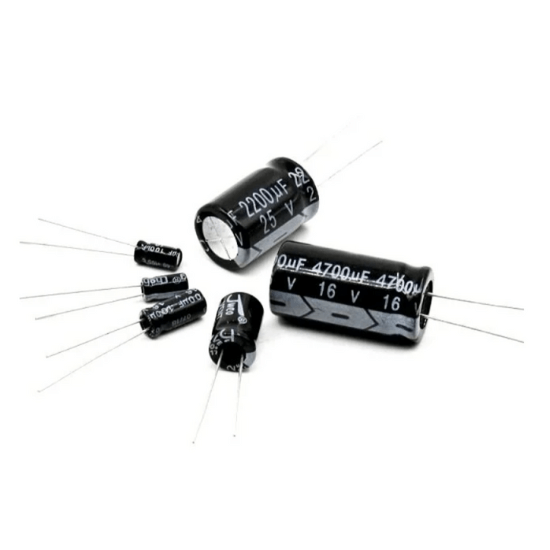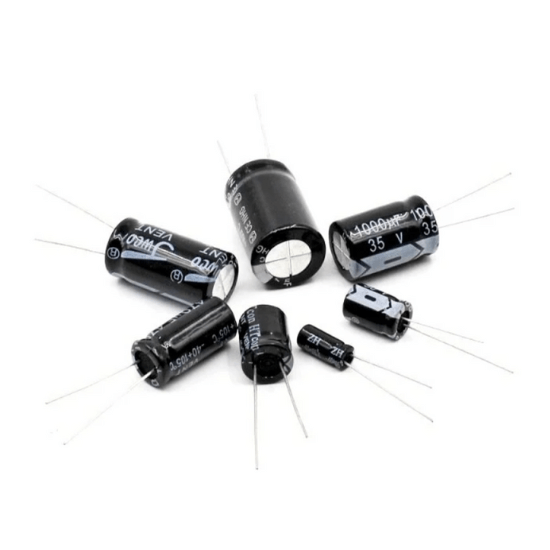10uF 63V Electrolytic Capacitor through hole (Pack of 10)
In stock
- Capacitance: 10uF
- Voltage: 63V
- Mounting: Through Hole
- Material: Aluminium
- Tolerance: ±20 %
₹65.00 ₹125.00 (Price Excl. GST) ₹55.08
In stock
CompareAn aluminum 10uF 63V, often only called an electrolytic capacitor, uses aluminum metal as one electrode, covered with a very thin layer of aluminum oxide as dielectric, and which has an
the electrolyte as its second electrode.
Aluminum electrolytic capacitors are typically used in power supplies and DC-DC converters for smoothing and buffering rectified DC voltages in many electronic devices. They are also used in industrial power supplies. Aluminum electrolytic capacitors are polarized capacitors because of their
anodization principle. They can only be operated with DC voltage applied with the correct polarity.
A 10uF 63V electrolytic capacitor is a common electronic component used in various circuits for filtering, smoothing, and energy storage purposes. Let’s break down its specifications and applications in detail.
Firstly, the “10uF” denotes the capacitance of the capacitor, measured in microfarads (uF). This indicates its ability to store electrical charge. A capacitance of 10uF means that the capacitor can store 10 micro coulombs of charge per volt across its terminals. This capacitance value is significant for various low to moderate-frequency applications, such as coupling and decoupling capacitors in power supplies, audio circuits, and filtering applications.
The “63V” rating specifies the maximum voltage that the capacitor can withstand across its terminals without risking breakdown. In this case, the capacitor is rated for a maximum voltage of 63 volts. This voltage rating ensures that the capacitor can safely operate within its specified limits without becoming damaged due to excessive voltage stress. It’s crucial to choose a capacitor with a voltage rating higher than the maximum voltage expected in the circuit to prevent failure or damage.
The term “electrolytic” refers to the type of capacitor construction. Electrolytic capacitors typically have a higher capacitance compared to other types like ceramic or film capacitors, making them suitable for applications requiring larger capacitance values. They are constructed using an electrolyte solution, which provides a large surface area for the electrodes, allowing for higher capacitance. However, electrolytic capacitors are polarized, meaning they have a positive and negative terminal and must be connected in the correct orientation in the circuit to prevent damage.
The “through-hole” designation indicates the style of the capacitor’s leads. Through-hole components have leads that are designed to be inserted through holes on a printed circuit board (PCB) and then soldered to the opposite side, providing a secure mechanical and electrical connection. Through-hole components are often preferred for their durability and ease of soldering, especially in applications where reliability is critical.
Now, let’s discuss the potential applications of a 10uF 63V electrolytic capacitor in various electronic circuits.
- Power Supply Filtering: In power supply circuits, electrolytic capacitors are commonly used for smoothing and filtering. Placing a 10uF capacitor across the output of a rectifier helps to reduce ripple voltage, ensuring a more stable DC voltage output.
- Decoupling Capacitors: These capacitors are placed near integrated circuits (ICs) to provide a local reservoir of charge, ensuring stable voltage levels during sudden current demands. A 10uF capacitor can effectively decouple the power supply rails of digital or analog ICs, reducing noise and improving performance.
- Audio Circuits: Electrolytic capacitors are frequently employed in audio circuits for coupling and signal filtering. A 10uF capacitor can block DC voltage while allowing AC audio signals to pass through, thus removing any DC bias from audio signals.
- Timer Circuits: In timer circuits, electrolytic capacitors control the timing intervals. By combining a 10uF capacitor with resistors, precise timing delays can be achieved in applications such as oscillators, timers, and pulse generators.
- Voltage Regulators: Electrolytic capacitors are often found in voltage regulator circuits to improve stability and transient response. Placing a 10uF capacitor at the output of a voltage regulator helps to reduce output impedance and improve load regulation.
In conclusion, the 10uF 63V electrolytic capacitor, with its specific capacitance, voltage rating, through-hole construction, and polarization, serves as a versatile component in electronic circuits, finding applications in power supplies, audio equipment, timing circuits, and voltage regulation systems, among others. Its reliability, affordability, and effectiveness make it a staple in the toolkit of electronic designers and hobbyists alike.
Typical applications of aluminum electrolytic capacitors with non-solid electrolytes are
- Input and output decoupling capacitors for smoothing and filtering.
- DC-link capacitors in AC/AC converters for variable-frequency drive and frequency
changers - Correction capacitors for power factor correction
Package Includes:
1 x 10uF 63V Electrolytic Capacitor through hole (pack of 10)
Specifications
| Capacitance | 10uF |
|---|---|
| Operating Voltage (VDC) | 63V |
| Tolerance(%) | ±20 |
| Operating Temperature Range (℃) | -40 to 80 |
| Mounting Type | Through Hole |
| Length (mm) | 11 |
| Width (mm) | 5.2 |
| Weight (gm) | 4 each |
| Shipping Weight | 0.01 kg |
| Shipping Dimensions | 4 × 4 × 2 cm |
Shipping & Returns
Due to the type of products we sell, we accept limited returns. Below are the conditions where we can accept a return request.
MANUFACTURING DEFECT
If you receive a product with a manufacturing defect, please notify us within 1 day of receiving the product, supported by the proper pictures and description. Once our support team accept the return, we will provide a replacement or a complete refund including the return shipping cost.
WRONG ITEM SHIPPED
If you receive a different product than the ordered one, please contact us within 1 day of receiving the product, supported by the proper pictures and description. Once our support team accept the return, we will provide a replacement or a complete refund including the return shipping cost.
LIMITATION OF RETURNS
We don’t accept returns for products damaged by improper use of the product. Moreover, we don’t accept the return if the ordered product is unsuitable for any specific application. Please read the product specifications and datasheet before selecting and ordering a product.
WHAT VOID WARRANTY?
If the product is subject to misuse, tampering, static discharge, accident, water or fire damage, use of chemicals & soldered or altered in any way.
SHIPPING
We ship all over India. Please contact our support team at info@inventkart.com for any questions related to shipping.
Based on 0 reviews
Be the first to review “10uF 63V Electrolytic Capacitor through hole (Pack of 10)”
You must be logged in to post a review.








There are no reviews yet.